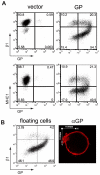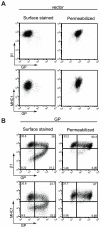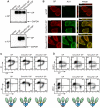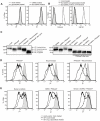Steric shielding of surface epitopes and impaired immune recognition induced by the ebola virus glycoprotein
- PMID: 20844579
- PMCID: PMC2936550
- DOI: 10.1371/journal.ppat.1001098
Steric shielding of surface epitopes and impaired immune recognition induced by the ebola virus glycoprotein
Abstract
Many viruses alter expression of proteins on the surface of infected cells including molecules important for immune recognition, such as the major histocompatibility complex (MHC) class I and II molecules. Virus-induced downregulation of surface proteins has been observed to occur by a variety of mechanisms including impaired transcription, blocks to synthesis, and increased turnover. Viral infection or transient expression of the Ebola virus (EBOV) glycoprotein (GP) was previously shown to result in loss of staining of various host cell surface proteins including MHC1 and β1 integrin; however, the mechanism responsible for this effect has not been delineated. In the present study we demonstrate that EBOV GP does not decrease surface levels of β1 integrin or MHC1, but rather impedes recognition by steric occlusion of these proteins on the cell surface. Furthermore, steric occlusion also occurs for epitopes on the EBOV glycoprotein itself. The occluded epitopes in host proteins and EBOV GP can be revealed by removal of the surface subunit of GP or by removal of surface N- and O- linked glycans, resulting in increased surface staining by flow cytometry. Importantly, expression of EBOV GP impairs CD8 T-cell recognition of MHC1 on antigen presenting cells. Glycan-mediated steric shielding of host cell surface proteins by EBOV GP represents a novel mechanism for a virus to affect host cell function, thereby escaping immune detection.
Conflict of interest statement
The authors have declared that no competing interests exist.
Figures






References
-
- Sanchez A, Khan AS, Zaki SR, Nabel GJ, Ksiazek TG, et al. Filoviridae: Marburg and Eboila Viruses. In: Knipe DM, Howley PM, Griggen DE, Lamb RA, Martin MA, et al., editors. Fields Virology: Lippincott, Williams & Wilkins; 2001. pp. 1279–1304.
-
- Mahanty S, Bray M. Pathogenesis of filoviral haemorrhagic fevers. The Lancet Infectious Diseases. 2004;4:487–498. - PubMed
-
- Alazard-Dany N, Volchkova V, Reynard O, Carbonnelle C, Dolnik O, et al. Ebola virus glycoprotein GP is not cytotoxic when expressed constitutively at a moderate level. J Gen Virol. 2006;87:1247–1257. - PubMed
-
- Volchkova VA, Feldmann H, Klenk HD, Volchkov VE. The nonstructural small glycoprotein sGP of Ebola virus is secreted as an antiparallel-orientated homodimer. Virology. 1998;250:408–414. - PubMed
Publication types
MeSH terms
Substances
Grants and funding
- U19AI082628-01/AI/NIAID NIH HHS/United States
- T32AI055400/AI/NIAID NIH HHS/United States
- U19 AI082628/AI/NIAID NIH HHS/United States
- P01 AI080192/AI/NIAID NIH HHS/United States
- T32 GM007229/GM/NIGMS NIH HHS/United States
- R01-AI43455/AI/NIAID NIH HHS/United States
- K12 GM081259/GM/NIGMS NIH HHS/United States
- P01AI080192/AI/NIAID NIH HHS/United States
- K12GM081259/GM/NIGMS NIH HHS/United States
- T32 AI055400/AI/NIAID NIH HHS/United States
- R01 AI043455/AI/NIAID NIH HHS/United States
- R01-AI081913/AI/NIAID NIH HHS/United States
- R01 AI081913/AI/NIAID NIH HHS/United States
- T32GM07229/GM/NIGMS NIH HHS/United States
LinkOut - more resources
Full Text Sources
Other Literature Sources
Medical
Research Materials

